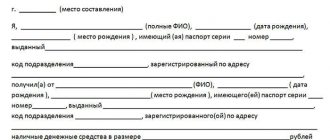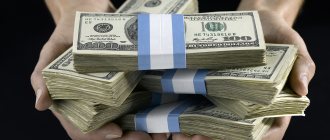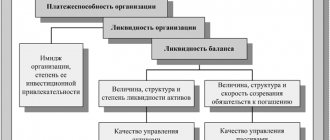Cash flow discounting is
a specific method that allows you to quickly assess the value of a company without resorting to overly cumbersome or abstruse computing equipment.
Economic theory, in essence, identifies the value of an enterprise (company) with the amount of discounted cash flows.
And although for many the term “discounting” itself sounds scary, we will consistently and inevitably prove the opposite by examining how the method works using a specific example.
Knowledge of the cash flow discounting method will certainly strengthen the investor's confidence in his abilities when selecting a particular company as an investment object.
Our task is not only to tell and show what is said, “at a glance”, what the cash flow discounting method is, but also to draw the reader’s attention to the advantages and disadvantages of this method.
Cash flow discounting: instead of introducing
Before we begin to present the theory of discounted cash flows, let us refresh our memory of some basic concepts that underlie this theory. Let's go, as they say, “from the opposite direction.”
So, the discount rate
is an indicator of the expected return on investment (you can read more about this concept here).
Under discounting
we will understand the process of comparing cash flows coming into a company in different periods.
And finally, the concept of “ cash flow”
", according to some dilapidated textbooks, is the unattached cash remaining with the company after all current (operating) expenses, including expenses on investments, have been financed.
Without knowledge of the designated concepts, it will be difficult to move further.
The ESSENCE of the discounting method is extremely simple.
First of all , it is necessary
, predict the cash flows of a firm (company) for some relatively short period (5-10 years), usually called
forecast period
.
Then, secondly
, make a forecast for cash flows for the period of time following the forecast, lasting indefinitely (
post-forecast period
).
Third
, we will need to calculate the discount rate, with the support of which, at the final stage, we will bring all future cash “streams” to the present time, and then, fourthly
,
we will sum up the resulting values and, as a result, we will obtain the desired value of the company.
So that theory doesn’t breathe heavily down our necks, let’s look at a specific example of calculating the value of a hypothetical company using the discounted cash flow method
.
Concept of discounting
You can compare the price of money today and after a certain period of time, that is, its purchasing power, using the discounting operation.
Discounted value, or DFC (discounted cash flow) is a reduction to the present moment in time of the value of cash flows expected in the future. In other words, we are talking about today's value of future money. All calculations are based on economic law, which states that the value of money invariably decreases over time. To avoid losses from the depreciation of money, it is necessary to bring all future cash flows to the current time. This applies not only to profits, but also to losses.
In preparation for the implementation of any investment project, i.e. one that is designed to make a profit, discounting of the resource is necessarily taken into account.
If an investor has free financial resources, it needs to be invested in the business, but the result of this investment should be an increase in capital. In business, fixed assets (long-term assets) are most often acquired, through the use of which additional profit is obtained for the provision of services or production of products.
You can understand the essence of the discount using a simple everyday example. A child is growing up in the family, and the parents want to provide him with his own housing after graduating from university. The child is 15 years old, and he will graduate from university at 22 years old. Therefore, parents have 7 years left. The approximate cost of the apartment is expected to be $30 thousand. The family council decided to put the existing savings into a deposit account with an interest rate of 10% per annum. This calculation is made using the formula that we will consider below.
Stage 1. Grouping of source data
So, let the financial and economic indicators of some be characterized in a FORECAST period of seven years by the following initial data (thousands of dollars):
| 1 | 2 | 3 | 4 | 5 | 6 | 7 | |
| Net profit | 100 | 105 | 111 | 118 | 138 | 155 | 161 |
| Depreciation | 10 | 11 | 11 | 12 | 14 | 16 | 16 |
| Working capital | -20 | -22 | -30 | -25 | -35 | -40 | 5 |
| Investments | -20 | -21 | -21 | -24 | -28 | -31 | -50 |
| Credit debt | -29 | -18 | -7 | 4 | 6 | 3 | 1 |
| Cash flow | 41 | 55 | 63 | 85 | 95 | 103 | 133 |
The minus signs on individual lines require some explanation.
Thus, the column “Investments” contains numerical data reflecting, among other things, capital costs associated with maintaining or developing the business.
They must be given with a minus sign.
The values in the “Working capital” column have both a minus sign (this means that the working capital has INCREASED, for example, due to changes in prices for materials or raw materials) and a plus sign (this means that the working capital has DECREASED in the corresponding amount ).
Stage 3. Post-forecast period: calculations, calculations...
First of all, let's calculate the growth of cash flow.
For example, it will be enough for us to take the value of the cash flow growth rate (the so-called “G” rate) in the post-forecast period of 1%.
Then you should calculate the cash flow for the 1st year in the post-forecast period. To do this, using the values from our table, you need to calculate the value of the formula
Cn+1 =
Cn * (1 + G)
, where
Cn
– the value of cash flow for the final year of the main period;
G
– as noted above, the rate of growth of cash flow at the end of the forecast period.
We will discount the resulting value to the last year of the forecast period using the formula:
Cp=
Cn+1 / ( r - G)
, where
r
– a parameter already known to us, indicating the size of the discount rate.
Now we are ready for the first calculations. Let’s simply substitute the values we know into the above formulas:
Cp= 133 * 1.01 / (0.10 – 0.01) = 1493.
Using the method to estimate real profitability
[ads-pc-4][ads-mob-4]
The very concept of discounting arose due to the fact that money becomes cheaper over time. Therefore, using the calculation using the formula given in the previous section, you can obtain data on the real return on investment. To do this, you need to carry out the calculations twice:
- substituting instead of the discount rate i the nominal percentage of profit that the selected security will bring;
using inflation as i.
The difference between the resulting numbers will be your real income. You can also use the total expected cash flow. For example, let's say you buy a bond with a 6% coupon. When you repay the paper in a year, you receive 1060 rubles. Inflation is 3%. In this case, the purchasing power is 1060 rubles. will be equivalent to today's 1029 rubles. If you purchased a paper at par, the real increase in your capital will be 29 rubles.
The figure below shows two graphs. They show the yield of a bond with a 6% coupon as a function of maturity and the rate of decline in the purchasing power of money, assuming inflation is 3%.
The main difficulty in using this method is that in reality the inflation rate cannot be predicted with certainty. The expected cash flow for most investment instruments is also a forecast value. It is predictable only for bonds with a constant or fixed coupon.
Stage 4. Discounting cash flows
The final stage of calculating the value of the company.
We simply discount (that is, divide by the appropriate discount rate) all the cash flow values at our disposal for each year of the forecast period and, separately, the post-forecast period:
| 1 | 2 | 3 | 4 | 5 | 6 | 7 | … | |
| Cash flow | 41 | 55 | 63 | 85 | 95 | 103 | 133 | 1493 |
| Discount rate | 1,1 | 1,101 | 1,102 | 1,103 | 1,104 | 1,105 | 1,106 | 1,106 |
| Discount cash flow | 37 | 50 | 57 | 77 | 86 | 93 | 120 | 1350 |
Finally, in our hypothetical example, the sum of all discounted cash flow values would be $1,870 thousand.
This is the meaning of cost.
The shine and misery of DCF
06/01/2020 Section: Useful information about investments
Difficulty level:
- 6
- 34910
- +14
- -1
In this material we will look at the applied value of the discounted cash flow method or DCF (discounted cash flow, one of the methods for assessing the value of a business).
The DCF (discounted cash flow) method, or the DCF method (discounted cash flow method), is one of the most popular methods for estimating the value of a company. But the popularity of the method does not mean its effectiveness in practice.
The DCF method is based on the assertion that the value of a company is the sum of the company's discounted cash flows.
Let us explore the terms from this definition in more detail.
- Cash flow is the cash remaining at a company's disposal after financing all of its investments and operating activities.
- Discounting is a way of comparing cash flows received at different times. Discounting is carried out by reducing the size of future cash flows to their size in the present using a discount rate.
- The discount rate is the return required by the investor from investing in the company.
To assess the value of a company, the company's cash flows are predicted up to a certain point in time (for example, for 5 years) and flows in the post-forecast infinitely long period. Then the discount rate is calculated and with its help the flow forecasts are brought to the current time. All received flows are summed up, and an estimate of the value at the moment is obtained.
Let's consider a simplified example of calculating the value of a company using the DCF method.
1. Calculation and forecast of cash flow during the forecast period (million rubles).
| Index | 1st year | 2nd year | 3rd year | 4th year | 5th year |
| Net profit | 100 | 110 | 120 | 150 | 150 |
| + depreciation | 10 | 10 | 30 | 30 | 20 |
| +/- change in working capital | -20 | -20 | -50 | -40 | 10 |
| +/- investment investments | -10 | -50 | -50 | -150 | -120 |
| +/- change in accounts payable | -50 | 0 | 0 | 50 | 0 |
| Cash flow | 30 | 50 | 50 | 40 | 60 |
As a rule, the forecast for the debt burden includes only its increase (with a “plus” sign), since it is problematic to predict in advance that the creditor will decide to repay his funds ahead of schedule. This is the so-called “perpetual refinancing concept,” which assumes that a company will be able to refinance its debts in any situation. In practice, there are always conditions under which the creditor may demand early repayment of the funds issued. During the crisis, many banks used formal reasons for this; it was almost impossible to take out new loans. This results in a sharp reduction in cash flow and can lead to bankruptcy of the company.
Let us explain that the change in the size of working capital comes with a “plus” sign in the case of a decrease in capital and with a “minus” sign in the case of an increase (the change can occur, for example, due to a change in prices for raw materials for production). Investment investments include capital expenditures (necessary for developing or maintaining a business), which come with a minus sign; the sale of fixed assets means a reduction in investment investments and comes with a “plus” sign.
2. At the second stage, the discount rate (rate “r”) is calculated. We will not consider in detail how to calculate the discount rate. Let us only note that the WACC method is most often used, to which we have devoted a separate material.
In our example we will use the discount rate 10%.
3. To calculate cash flow in the post-forecast period, it is necessary to determine the rate of sustainable growth of the company's cash flow during this period. Let's say that in our example, the company's cash flow will increase at a rate of 2% per year (rate "g"). Then, using the Gordon formula, the cash flow in the post-forecast period is calculated, reduced to the last forecast year:
CF post = CFn+1 /( r – g ) ,
where CFn+1 is the cash flow for the first year of the post-forecast period (for calculation, it is necessary to increase the cash flow for the last year of the forecast period by the growth rate using the following formula: CFn +1 = CFn * (1 + g ) );
g – estimated (predicted) growth rate of cash flow for an infinite period;
r is the discount rate.
Substituting the values of the components into the Gordon formula, we calculate the cash flow in the post-forecast period for our example:
CF post = 60 * 1.02/(0.10 – 0.02) = 765
4. At the fourth stage, all calculated cash flows are discounted. To do this, the cash flow is divided by the discount rate using the following formula:
CF disk = CFj /(1 + r)j ,
where j is the forecast year;
CFj is the cash flow for a certain forecast year.
| 1st year | 2nd year | 3rd year | 4th year | 5th year | Postprog. period | |
| Cash flow | 30 | 50 | 50 | 40 | 60 | 765 |
| Discount coefficient | 1,10 | 1,102 | 1,103 | 1,104 | 1,105 | 1,105 |
| Discounted Cash Flow | 27,3 | 41,3 | 37,6 | 27,3 | 37,3 | 475,0 |
5. The final cost using the DCF method is obtained by summing up the resulting discounted cash flows.
In our example, the value of the company was 646 million rubles.
The idea that a company's value depends on its ability to generate cash flows for shareholders is not itself problematic. The mathematical apparatus used is simple and understandable, which was also one of the reasons for its active popularization. However, in the process of applied use of the DCF method, several significant shortcomings can be identified.
1. High sensitivity of the forecast to the discount rate and the size of cash flows.
Let's say that some time after our initial forecast (RUB 646 million), the discount rate increased by only 2 percentage points to 12%. This will lead to a change in the current cost estimate by 21% (price reduction to RUB 509 million).
A change in earnings forecast or other metrics involved in calculating cash flow will also result in a material change in the company's valuation. Let’s say that the profit included in the calculation, starting from the second year of the forecast, decreased by 20%. This will lead to a reduction in the company's value by 48% (to RUB 333 million).
2. High sensitivity to input data is a consequence of another drawback - the use of an infinitely long forecast period.
If it is difficult to accurately predict economic indicators for 1 year in advance, then for 5-10 years in advance it is almost impossible. Given the large number of variables involved in the forecast, the probability of error is very high. And high sensitivity to errors leads to significant distortions in cost estimates.
3. Under the DCF method, all cash flow used in the calculation is considered to be available to shareholders. In practice, the situation where the full cash flow is available to shareholders is the exception rather than the rule. Often, dividend payments, even in the nearest forecast years, are less than the amount of cash flow.
4. The share that the post-forecast period contributes to the company’s valuation can be extremely high (in our example, 74%). This ratio may indicate that in the short term the company’s cash flows do not cause optimism, while in the long term (or rather, infinite) impressive growth can be envisaged, which will make a significant contribution to today’s business valuation. Unfortunately, as we wrote earlier, it is impossible to predict with acceptable accuracy even 5-10 years in advance.
As can be seen, the practical use of the DCF method is complicated by several significant drawbacks. Moreover, these shortcomings create room for manipulation, which can be used for their own purposes by unscrupulous analysts or investment bankers. The same investment house can produce vastly different valuations of a company planning an IPO in a short period of time, with valuation declines typically occurring immediately after the IPO.
For those who still use this method or are guided by the estimates obtained when using it, we would like to give several recommendations that you need to pay attention to when using the DCF method.
- The discount rate is the return required by the investor from investing in the business being valued (company shares). Therefore, pay attention to its calculation and size. The situation seems paradoxical when the discount rate in DCF is lower than the yield on the bonds of the company being valued currently traded on the market.
- It is necessary to pay attention to the distribution of cash flows in the forecast and post-forecast periods. If the contribution of cash flows of the first five years to the company's valuation is less than 30%, then this may indicate an extremely low probability of the forecast being realized and a “bet on the future” that cannot be predicted.
- Despite the fact that in practice the cash flow is not fully paid out in the form of dividends, this is not a reason for disappointment. A dividend is just one form of shareholder benefit from investing in equity instruments. Much more important is the increase in market value. Even when spent on capital expenditures, profits remain with the company (increasing its book value) and continue to work in the interests of shareholders under the return on equity (ROE) rate. If the company's ROE is higher than market rates of return, then reinvesting cash flow may be more profitable for shareholders than paying dividends (due to a higher rate of increase in business value). Therefore, along with cash flow, it is necessary to take into account the amount of net profit and the share of investments in net profit.
Benefits of Discounting Cash Flows
The main advantage of the method is simplicity, logic and clarity.
The hypothesis underlying the method about the supposedly existing connection between the value of a company and, so to speak, its ability to generate regular cash flows, deserves attention and has strict mathematical confirmation.
Without a doubt, in a number of cases the proposed method can be recommended for use, especially when it is necessary to obtain quick estimates of the value of certain companies.
Disadvantages of Discounting Cash Flows
Alas, not everything is so simple under the sun.
The discounted cash flow method, used to obtain numerical values of a company's value, also has a number of disadvantages that can, in a sense, spoil its reputation.
And these shortcomings boil down to the following:
[1]
excessively high share of the discounted cash flow value relating to the post-forecast period (usually three quarters or more);
[2]
the practical impossibility of predicting economic and other indicators for more or less long periods (from a year or more), while the method “attempts” to manipulate data that characterizes an essentially endless post-forecast period;
[3]
strong dependence of the calculation results on the initial values of both cash flows and the corresponding discount rates; even a slight change in these values by 1-2 points can change the final forecast estimate of the company’s value by 10-20%;
[4]
in the calculation process it is assumed that shareholders have the ability to control cash flows in full, whereas in reality this rarely happens.
All of the listed shortcomings, naturally, can do a bad job, especially if unscrupulous capital managers or pseudo-analysts get down to business, since they allow them to distort the actual state of affairs in the company...
Comparative analysis of methods for calculating discount rates
In economic analysis, there are dozens of ways to estimate the discount rate. Each of them has a number of advantages and disadvantages.
To present the topic more fully, the most common calculation methods are given below in the form of a comparative table.
| Methods and models for calculating the rate of return | The essence of the method | Advantages of the method | Disadvantages of the method |
| CAPM model | The level of risk of a particular asset is offset by the returns from another investment. | Market risk is taken into account | The narrow focus of the method; to assess risk, it is necessary to have shares on the stock market |
| Gordon model | The calculation formula is inversely proportional to the relationship between investments at the beginning of the period and the discount rate | Relative simplicity of the method | It is necessary to have sustainable dividends and shares in the stock market |
| WACC model | Involves using each funding source to calculate the average interest rate | Takes into account not only the investor’s or owner’s own capital, but also borrowed capital | Relatively complex calculation |
| Model ROA, ROE, ROCE, ROACE | Allows you to obtain an assessment of profitability taking into account only equity (ROE) or with attracted capital (ROCE) | Takes into account return on equity | Ignores risk factors |
| E/P method | Formula that represents the ratio of the market value of a stock to the annual profit | Takes market risks into account | Forced use of quotes |
| Premium valuation method | Implies the use of reference data depending on the project type and risk premium | Allows you to take into account risk criteria | Sufficient subjectivity |
| Assessment method based on expert opinions | Takes into account all possible risk factors | Sufficient subjectivity |










